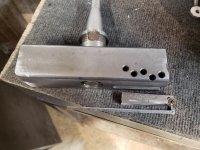Overland
Stainless
- Joined
- Nov 19, 2017
- Location
- Greenville, SC
I have a Supermax 5 hp knee mill, and I'm making a flycutter for it.
I have a piece of 1-1/2" plate, about 9" diameter.
I good stout tool (did I really right that ?), is good for vibration etc, but it looks massive compared to a Cat 40 shell mill holder.
Thoughts on the diameter, thickness and weight please ?
Thanks
Bob
I have a piece of 1-1/2" plate, about 9" diameter.
I good stout tool (did I really right that ?), is good for vibration etc, but it looks massive compared to a Cat 40 shell mill holder.
Thoughts on the diameter, thickness and weight please ?
Thanks
Bob


